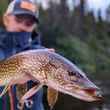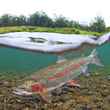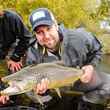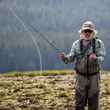Most people don’t think of tenkara when they think of fishing streamers. Dries, soft hackles, sakaska kebari? Yes. Streamers? Not so much. But tenkara can be an effective method for fishing streamers, especially in the winter months when the dries and terrestrials are taking a break.
What makes a tenkara rod an effective streamer tool is the ability to subtlety manipulate the streamer in the water. The soft action of the tenkara rod helps impart small strike-inducing twitches or jumps.
This is a downstream fishing technique for the most part, but you can use a dead drift, pause and twitch as well. Because of the versatility of the tenkara rod, you have a range of options.
Line length
I recommend fishing a stiffer action rod like the Patagonia 10 foot, six-inch Soft Hackle. You can use a longer line then when fishing dries because you will be dropping the line on the water as you fish downstream. My line of choice on my local spring creeks has been 15 to 18 feet of Patagonia’s floating line made of a small-diameter, hard mono core and a supple PVC coating.
Attach a seven-foot, six-inch 3x leader to a floating line with a perfection or double surgeon's knot. I know this seems like a large knot and it would be for dry flies, but the goal is to keep tension on the line and the drag from the knot helps. The longer leader helps get the streamer down lower in the water column.
You can also switch to a shorter main line (12 feet) and longer leader (9 feet) if you are fishing deeper water or not getting the streamer down where you want it.
Casting and fishing
Make a quartering (45-degree) downstream cast. Then, as soon as the flies are in the water, make a downstream mend. This mend gets the slack out and swings the streamer across the current. The key is to maintain direct control of the fly.
When the flies are downstream you can make subtle twitches by putting your thumb on top of the rod and squeezing the cork with your fingers. You don’t want to make big moves, just a small twitch to make the fly pulse. Time and again I have had fish hit at the end of the twitch, thanks to their predatory instinct.
Because you have heavy flies you need to use a cast that keeps tension in the system. I use a Belgian cast most of the times. Slide the line along the water starting with the rod tip low, then slowly raise the rod. When about half the line is behind you, smoothly accelerate forward, stopping at a point where the line can unroll in front of you just above the water. Keep the line in constant motion and under tension until you come to the stopping point for your forward cast.
Fly choices
The streamers in my box are typically bead or cone head wooly buggers, kreelex, retrievers and sculpin imitations. I have found that size 6 is about as big as I feel comfortable tossing with a tenkara rod. Most of the time I am swimming them, but the retriever can be dead drifted as well.
Recently I adapted the soft hackle technique I described in Two Fly Tenkara to my streamer fishing. I have added a soft hackle or nymph on a dropper. The easiest way to tie on the dropper is with a dropper loop and a separate piece of tippet attached to the leader above streamer.
Tie in a length of tippet for the streamer, say 3 feet. Now take six to nine inches of the same size tippet and tie a perfection loop or double surgeons loop on one end. Hitch the section of tippet to the leader by taking the tag end through the loop and tightening it above the knot to the last section of tippet. Tie your fly to the tag end and you are set to go.
A word of caution here; two fly rigs, if not cast well, can tangle quickly, so casting fundamentals are key. The most fundamental of fundamentals is keep slack out of the system.
The takeaway
If you are going to go down and dirty, don’t put your tenkara rig on the shelf. You can fish streamers effectively and if the dries start to pop, you can get in the game with a quick line change.






























Comments
LARRY TULLIS replied on Permalink
Thanks for the article! Back in the 80's I tried nymphs and streamers with long telescopic, reeless fiberglass panfish poles on the Provo River here in Utah, but they were too heavy and whippy to be enjoyable, but did work well. This was long before I ever heard the word "tenkara". I had grown up in Hawaii fishing cane poles so when tenkara was introduced in America by Tenkara USA, I immediately jumped on the bandwagon and used the same nymphing and streamer rigs I had tried before but with the much nicer to use graphite rods. However, after breaking them numerous times (through guiding and my own abuse) I went to the Dragontail Hellbender, which proved to be stiffer and more durable for those methods and the longer rods handle bigger water, heavier tippets and bigger fish too. Although I mostly nymph with tenkara, I also do streamers (poppers and mice too), dries (and dry/dropper) and wets. While tenkara may not be the best rod in all situations, its good to know all it's abilities and versatility.
Pages